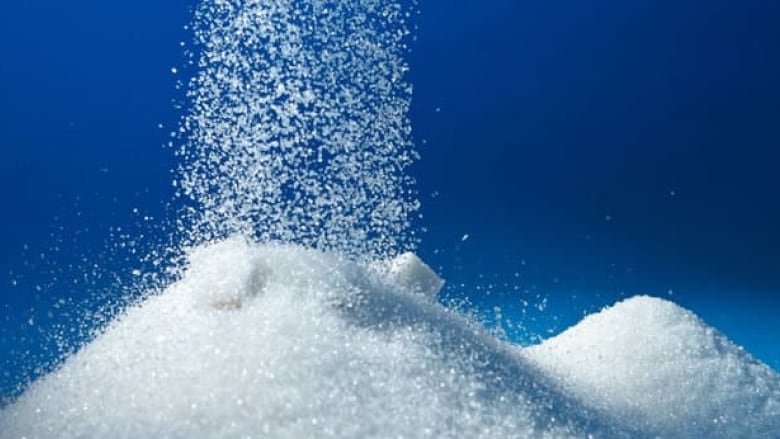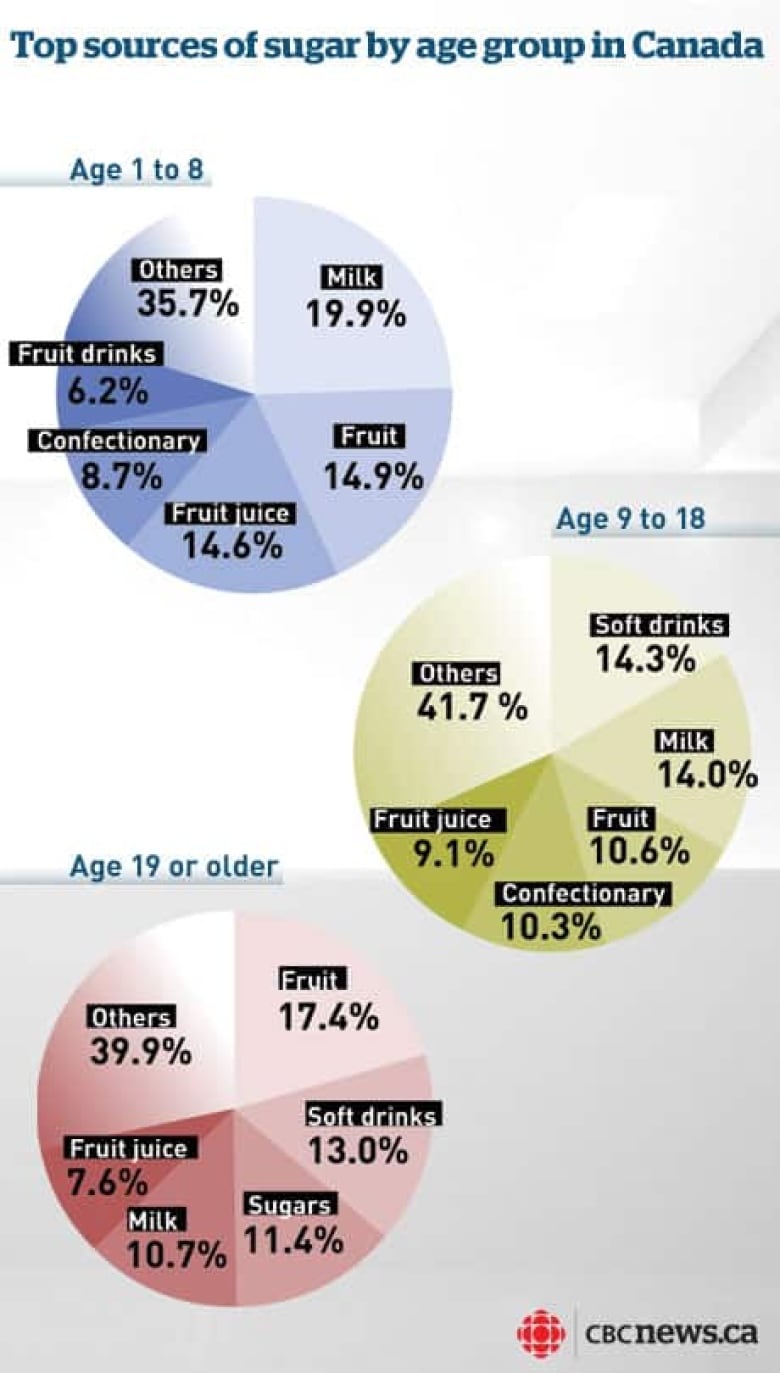10 things to know about sugar

We sprinkle it into drinks, sing about it, and even use it as a term of endearment but how much do we really know about sugar?
Here are10 insights into the sweet andseemingly ubiquitous substance.
1. Sweet by nature
Almost all plants contain sucrose, but few are commercially viable sources of the substance. Sugarcane and sugar beets are special because they have a high enough concentration of sucrose to harvest.
How many teaspoons of sugar in that?

The sucrose molecule is identicalregardless of whetherthe sugar is made from cane or beets, and it has the same number of calories: 14 per teaspoon.
CBC News researched the sugar content in some common foods and drinks, and determined the equivalent number of teaspoons of sugar in each.See the chart.
Sugarcane from the East Indies was the first sugar crop to be cultivated. It doesnt have a very long shelf life, so itmust berefined before it can decompose.
Sugar beets were developed as a crop in 19th-century Europe.Their sugarissturdy enough to be stored and is normally processed into white sugar in one stage.
In Canada, the sugar industry primarily refines raw cane sugar, but alsorefines sugar beets. Canada'sfirst knownsugar refinery was established in Halifax in 1817.
Today, there are cane sugar refineries in Montreal, Toronto and Vancouver. There is alsoone sugar beet plant in Taber, Alta.
2. Were eating less sugar that is 100 per centsucrose
Canadians are consuming less natural sugar than they were a few decades ago, according to figures released by Statistics Canada in 2010.
This is partly becausethe food and beverage industry is relying less on sucrose and more on high-fructose corn syrup.
One thing that setsnatural or table sugarapart is that it is 100 per cent sucrose and does not contain reactive carbonyls, which are highly reactive compounds associated with the "unbound" fructose and glucose molecules present in human-made sugars.
The fructose and glucose componentsinnatural sugarare"bound" and chemically stable.
3. The jury is out on high-fructose corn syrup
Several researchers suggest high-fructose corn syrup, which does not occur in nature, may be linked to certain health risks, including the onset of diabetes, hypertension and liver disease. The most common form of the syrup contains 45 per cent glucose and 55 per cent fructose.
The food industry disputes such studies, andsome expertsincluding the Center for Science in the Public Interestagree that more research is needed on thepossible risksof high-fructose corn syrup.
What is clear is that the public is taking in much more of the manufactured sweetener.
In the U.S., reported consumption of high-fructose corn syrup increased 1,000 per cent over two decades, according to a 2004 study in the American Journal of Clinical Nutrition.
4.Canadians consume about 26 teaspoons of sugarper day
Canadians get about 21 per cent of their daily calories from sugar, according to a 2011 Statistics Canada report onthe sugar consumption of Canadians of all ages.
The report, which didn't distinguish between naturally occurring and added sugars, noted that on average Canadians consume 110 grams (26 teaspoons) of sugar per dayan amountconsidered moderate by at least one dietitian.
While 31 per centofCanadians' dailysugar comes from fruit andvegetables, a higher percentage 35 per cent comes fromthe "other" foods category, includingdrinks and candy, that are high in added sugars.
5. Sources of sugar intake vary by age group
When the data from 35,000 respondents was broken down by age, however, the daily intake varied among Canadians. Teenage boys took in about 41 teaspoons of sugar per day, while women aged 71 and over consumed 20 teaspoons per day.

This 2011 datawas the first of its kind in Canada, and Statistics Canada plans to repeat the study it in 2015.
6.Diabetics consume more sugar than recommended
Althoughpeople with diabetestake insignificantly less sugar thantheir non-diabetic counterparts, their average consumption generally exceeds the recommended level, according to the aforementioned2011 Statistics Canada study.
The21st-century epidemic
The International Diabetes Federation callsdiabetes the epidemic of the 21st century.
The federation expects that by 2025, the number of people living with diabetes will hit 380 million if nothing is done. Click here to explore the major effects of the diseasein an interactive feature.
Or read anin-depth overviewof the disease.
There arethree main types of diabetes, but nine out of 10 Canadians with diabetes have Type 2, which is usually controlled through diet.
People with diabetesare generally advised to limit sugar consumption to 10 per cent of daily calories, but those surveyed took in an average of 73.4 grams of sugar per day which is roughly 17 per cent of daily intake.
Diabetes interferes with the body's ability to produce or properly use insulin, a hormone that is essential for the proper use of the energy in our food. If your body is not producing or properly using insulin, you will have too much or too little glucose in your system.
7. Carbohydrates affect blood sugar
Suzanne Danner, a naturopathic doctor in Winnipeg, warns that simple carbohydrate foods, like white rice and noodles, raise blood sugar very quickly. The body releases insulin to get blood sugar down, and if that cycle happens too often some people develop insulin resistance a risk factor for Type 2 diabetes.
Type 2 diabetes doesn't develop overnight, but having high amounts of sugar in the diet is a risk factor that Canadians can avoid by taking charge of their diet, Danner said.
One ways to keep track of your carbohydrate consumption and howit affects your blood level is to check howfoods are ranked in the glycemic index (GI).Foods that are digested slowlyhave a lower GI 55 or less and are healthier choices because blood sugar rises slowly and falls gently over a longer period of time.
On the flip side, high GI foods 70 or more are quickly digested, and can cause your blood sugar to spike and drop.
8. Boys are most at risk of obesity from consuming sugary drinks
Boys who drink pop and other sweetened beverages are at higher risk of obesity, according to therecent Canadian Community Health Survey.
Boys aged six to 11 years who drank the most sweetened drinks, about 553 grams a day of soft drinks, had about double the risk of being overweight and obese compared with their peers, after taking factors like household income into account, the researchers said.
Although Canadian intakes haven't reached U.S. levels, sugary drink consumption is on the rise, said nutritionprofessor Susan Whiting of the University of Saskatchewan.
9. There are a few sugary items you should avoid as a rule
Young boys aren't the only oneswho enjoysoft drinks, but they should be indulgences rather than a regular habit. Next time youre navigating the grocery store or cafeteria, you may want to steer clear of the following items.
- Soft drinks: Soft drinks have been dubbed "liquid candy" for a reason. They are the biggest source of sugar in the average diet. Same goes for many frozen flavoured drinks.An extra-large Slurpee, for instance, contains up to 39 teaspoons of sugar.
- Fruit "drinks," "beverages," "ades," and "cocktails": These beverages are essentially non-carbonated soft drinks. Many contain onlyfive to 10 per cent juice.
- Most sweet baked goods: Limit candy, cookies, cakes, pies, doughnuts, granola bars, pastries, and other sweet baked goods. And note that fat-free cakes, cookies, and ice cream may have as much added sugar as their fatty counterparts and they're often high in calories. "Fat-free" on the package doesn't necessarily mean low calorie.
- Sugary cereals: Look for breakfast cereals that have no more than eight grams of sugar per serving.
Canada's Food Guide also has compiled alist of foods to limit, as well as a list of healthier alternatives.
10. 'Unsweetened' can only mean one thing
When it comes to nutrient content claims, not allinformation is created equal.Canada's Food and Drug Regulationshaveoutlined certain terms and wordingthatsavvy consumers can use to evaluateclaims about sugar content.
Permitted "sugars" claims include the following:
Sugar-related claims | Regulations |
| Sugar-free: free of sugar, no sugar, 0 sugar, zero sugar, without sugar, contains no sugar, sugarless | Contains |
| Reduced in sugar: reduced sugar, sugar-reduced, less sugar, lower sugar, lower in sugar | Compared to a similar reference food, contains > 25% less sugars and > 5 g less sugars/reference amount. |
| Lower in sugar: less sugar, lower sugar | Compared to a reference food of the same food group, contains > 25% less sugars and > 5 g less sugars/reference amount. |
| No added sugar: no sugar added, without added sugar | Contains no added sugars, no ingredients containing added sugars or ingredients that contain sugars that substitute for added sugars. |
| Unsweetened | Meets requirements for "no added sugar" and contains no sweeteners. |












_(720p).jpg)


 OFFICIAL HD MUSIC VIDEO.jpg)
.jpg)



























































































